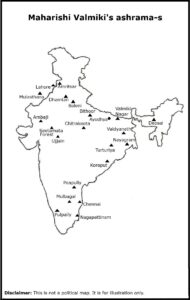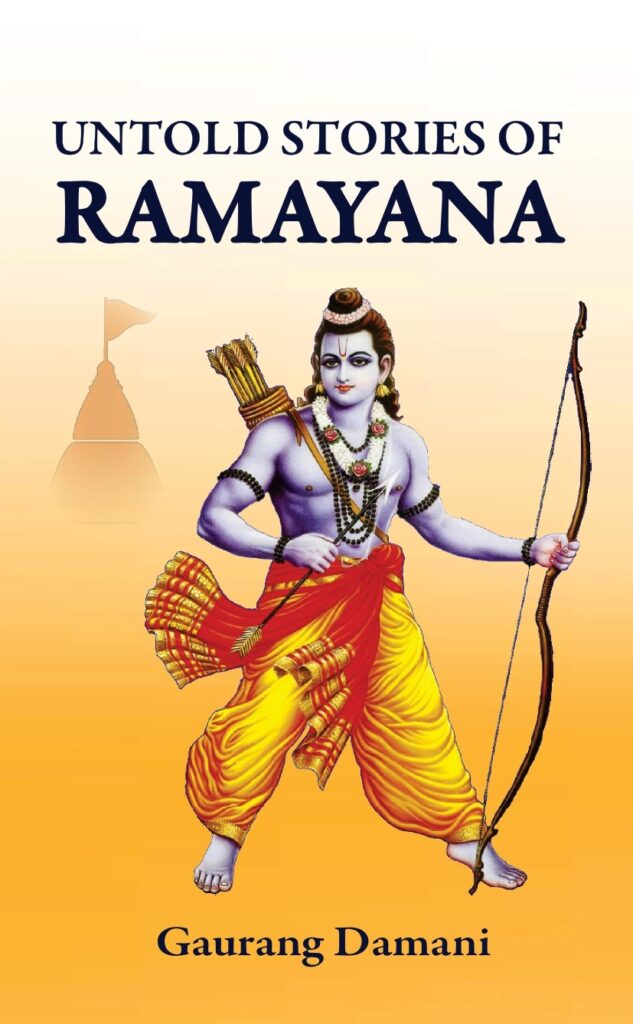 Agnisharma (aka Ratnakara) had fallen in the company of wicked people. He became a forest robber on the outskirts of Mulasthana, present-day Multan in Pakistan. One night he met Devarishi Narada and the Saptarishi-s (7 learned sages) who were crossing the forest. They were not afraid of him. He clarified that he became a robber because he had to provide for his family. Rishi Atri told him to go home and ask his family members if they would share his sins for such a livelihood. The pious sages promised that they would wait there till he returned.
Agnisharma (aka Ratnakara) had fallen in the company of wicked people. He became a forest robber on the outskirts of Mulasthana, present-day Multan in Pakistan. One night he met Devarishi Narada and the Saptarishi-s (7 learned sages) who were crossing the forest. They were not afraid of him. He clarified that he became a robber because he had to provide for his family. Rishi Atri told him to go home and ask his family members if they would share his sins for such a livelihood. The pious sages promised that they would wait there till he returned.
At home, his father, mother, wife, and son one after another all replied that he alone had to bear his karma-phala (results of one’s deeds) of his crimes. A shocked Agnisharma returned to the sages in the forest and fell on their feet. Narada told him that every sinner can become a good human being by putting in sincere efforts. As per Narada’s guidance, he moved to Mahakala-vana near present-day Ujjain in Madhya Pradesh state to perform severe tapasya (penances). While in penance, some years went by causing a valmik (an ant hill) to cover him. Soon after, he attained great spiritual powers and became known as Valmiki.
Valmiki was a friend of Ayodhya’s Suryavanshi King Dasharatha. Rishi Valmiki was present in his royal assembly when Rishi Vishwamitra came to take Rama to the forest to kill the Rakshasa-s. When Dasharatha hesitated to send Rama, Rishi Vasishtha explained to Rama the process of attaining moksha. Valmiki later recited this remarkable spiritual text ‘Yoga Vaasishtha’ also known as Maha-Ramayana.
Later, Rama, Seeta, and Lakshmana left Ayodhya during their vanvasa. When they reached Chitrakoota in present-day Madhya Pradesh state, they met Valmiki with respect and exchanged pleasantries.
After their long travels, they settled in Panchavati, present-day Nashik in Maharashtra state. Thereafter, Rama, Seeta, and Lakshmana visited Pushkara in present-day Rajasthan state to perform shraadha rituals for their departed ancestors. En route, they stopped at the present-day Seetamata Wildlife Sanctuary near Chittorgarh in Rajasthan state. This forest has a Seeta temple, Rishi Bhrigu’s well, and a Valmiki ashrama.
After killing the evil Ravana, Rama and Seeta spend a blissful 10,000 years in Ayodhya. Due to a washerman’s comment to his wife who had stayed at another man’s house, Rama was shattered. Rama gave Lakshmana a choice to either kill him or drop a pregnant Seeta at Rishi Valmiki pious ashrama on the banks of River Ganga at present-day Bithoor in Uttar Pradesh state. There, some children of other learned sages heard Seeta’s weeping and reported back to Valmiki.
Valmiki consoled Seeta, saying he knew who she is, and why she is here and is aware of her innocence. He added that the wives of various Rishi-s of the ashrama would take good care of her. The ladies made Seeta comfortable with aarti, a traditional welcoming ritual. Seeta asked Valmiki for a way to reunite with Rama. As per his recommendation, she performed the Sanyogi-karana vrata.
Seeta gave birth to twins in the divine environment of the ashrama. With God Brahma’s blessings, Valmiki sat down in yoga and saw all the events of Ramayana as if in real life. He composed the epic Ramayana which he taught the twins Kusha and Lava when they grew up. He also taught them the Vedic scriptures and the secrets of archery.
Back in Ayodhya, Rama decided to perform an Ashwamedha yagnya. The meandering horse reached Valmiki’s ashrama on the banks of River Ganga, while he was attending Rama’s Ashwamedha ceremony. Kusha and Lava defeated many stalwarts like Bharata’s son Pushkala, Seeta’s brother Lakshminidhi, Shatrughna, Hanuman, and Sugreeva. The humbled warriors returned to the site of the yagnya with the horse. When Rama heard about the astonishing events at Valmiki’s ashrama, he went to meet the sage. Valmiki disclosed that the talented twins are his sons, and wanted Rama to accept Seeta and his 2 sons.
Rama requested Lakshmana to get Seeta and his 2 sons. Even though Lakshmana stated that Rama now longs for her company, Seeta refused to join him but sent her reluctant sons. Rama was heartbroken to hear about Seeta’s decision but resent Lakshmana. Meanwhile, Valmiki told Kusha and Lava to sing all the shlokam they have memorized from the 6 books of his composition of Ramayana. On hearing it, Rama, like many others, shed tears of joy. Rama embraced them firmly to his body.
Meanwhile, Seeta agreed to meet Rama. At the yagnya location, in the presence of other illustrious sages, Valmiki declared that from the powers of his tapasya (austerities) of thousands of years, he can say with confidence that Seeta is pati-vrata (chaste). Rama admitted he knows that but the public scandal forced him to take that decision. Seeta prayed to Bhoomidevi (Goddess Earth) to receive her if she is pure. An extravagant throne emerged from the ground and Seeta willingly descended into Mother Earth’s lap. This is believed to be at the present-day Seeta samahit-sthal between Varanasi and Prayagraj in Uttar Pradesh state. There was a continued shower of flowers from the sky.
Rishi Valmiki’s other ashrama-s were in present-day:
- Lahore
- Ram tirath near Amritsar in Punjab state
- Dhamtan (Dharmasthan) near Narwana in Haryana state
- Seetamata Wildlife Sanctuary in Rajasthan state
- Near Koteshwar Mahadev temple in Ambaji in Gujarat state
- Chitrakoota in Madhya Pradesh state
- Bithoor on the banks of River Ganga in Uttar Pradesh state
- Baleni village on the banks of River Hindon near Meerut city in Uttar Pradesh state
- Valmiki Nagar on the Bihar state border with Nepal
- Deosal Shiva temple in Morigaon district of Assam state
- Tapoban Valmiki ashram in Nayagram in Jhargram district of West Bengal state. There is a Rameshwar Shiva temple nearby
- Tapovan Hill near Vaidyanath jyotirlinga temple in Deoghar in Jharkhand state
- Balmiki ashram in Koraput district of Odisha state where Valmiki language is spoken even today
- Turturiya in Chhattisgarh state
- Valmiki caves and its Shivalinga at Boyavandlapalle village near Peapully of Andhra Pradesh state. It has many rock formations like Nandi, elephants, and Rudraksha
- Aavani village near Mulbagal in Kolar district of Karnataka state
- Pulpally in Wayanad district of Kerala state
- Thiruvanmiyur in Chennai in Tamil Nadu state
- Valmiki’s siddhar jeevan samadhi at the Ettukudi Murugan temple near Nagapattinam in Tamil Nadu state

This article is an excerpt from the book
‘Untold stories of Ramayana‘ by Gaurang Damani. The book is available on Padhega India and other online stores.
This article also appeared on the Hindu Post website
